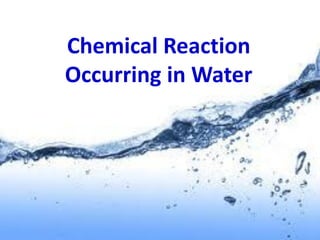
Chemical Reactions in Aqueous Solutions
- 1. Chemical Reaction Occurring in Water
- 2. Aqueous Solution • The word aqueousmeans pertaining to, related to, similar to, or dissolved in water. • Asolution in which the solvent is water.
- 3. • Aqueous solutions that conduct electric current efficiently contain strong electrolytes, while ones that conduct poorly are considered to have weak electrolytes. Those strong electrolytes are substances that are completely ionized in water, whereas the weak electrolytes exhibit only a small degree of ionization in water.
- 4. Three important types of reactions in water:
- 5. Precipitation Reactions • In a precipitation reaction, an anion and a cation contact each other and an insoluble ionic compound precipitates out of solution.
- 6. Example: • When aqueous solutions of silver nitrate, AgNO3, and salt, NaCl, are mixed, the Ag+ and Cl- combine to yield a white precipitate of silver chloride, AgCl: Ag+(aq) + Cl-(aq) → AgCl(s)
- 7. Acid-Base Reactions • Is a chemical reaction that occurs between an acid and a base
- 8. Example: • When hydrochloric acid, HCl, and sodium hydroxide, NaOH, are mixed, the H+ reacts with the OH- to form water: H+(aq) + OH-(aq) → H2O HCl acts as an acid by donating H+ ions or protons and NaOH acts as a base, furnishing OH- ions.
- 9. Oxidation-Reduction Reactions – In an oxidation-reduction or redox reaction, there is an exchange of electrons between two reactants. The species that loses electrons is said to be oxidized. The species that gains electrons is said to be reduced. An example of a redox reaction occurs between hydrochloric acid and zinc metal, where the Zn atoms lose electrons and are oxidized to form Zn2+ ions: • Zn(s) → Zn2+(aq) + 2e-
- 10. – The H+ ions of the HCl gain electrons and are reduced to H atoms, which combine to form H2 molecules: 2H+(aq) + 2e- → H2(g) – The overall equation for the reaction becomes: Zn(s) + 2H+(aq) → Zn2+(aq) + H2(g)
